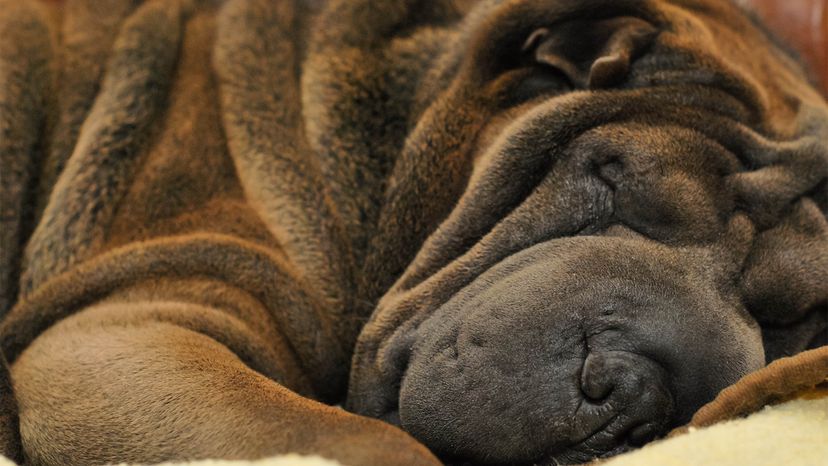 “Originally bred as guard dogs and hunters, Shar-Pei are described as intelligent, regal and independent and are noted for their fierce loyalty to their owners. Life On White/Getty Images
“Originally bred as guard dogs and hunters, Shar-Pei are described as intelligent, regal and independent and are noted for their fierce loyalty to their owners. Life On White/Getty Images
Looking for a dog that will turn heads or stop passersby in their tracks? Check out the Shar-Pei. With their unique loose and "wrinkled" skin and hippopotamus-shaped muzzle, Shar-Pei are a unique member of the canine family.
The breed originated in China — the name Shar-Pei literally translates to "sand skin." And this stocky pooch — a full-grown Shar-Pei stands about 2 feet (0.6 meters) high and weighs between 45 and 60 pounds (20 to 27 kilograms) — lives up to its name.
The Shar-Pei coat is short and coarse, falling in heavy folds around the dog’s head, neck and shoulders. They are typically fawn-colored, but the American Kennel Club (AKC) lists up to 17 different colors. In addition to their prominent muzzle, Shar-Pei have small, deep-set eyes and tiny ears. Their tongues are blue-black.
But it’s the wrinkles that make Shar-Pei so memorable. In an email interview, Dr. Kerstin Lindblad-Toh of Uppsala University in Sweden writes that a Shar-Pei’s wrinkles are caused by the hyaluronic acid synthase 2 (HAS2) gene. "HAS2 encodes an enzyme synthesizing hyaluronan, a major component of the skin," she says. "The hyaluronan is up-regulated and accumulates in the thickened skin of Shar-Pei."
In hyper-layman’s terms, hyaluronan is a sort of "gel" around the cells in the skin. Among other things, it aids in hydration and elasticity of the skin. In a Shar-Pei, the HAS2 gene goes into overdrive creating way too much hyaluronan and that causes the trademark wrinkles, which are especially visible in Shar-Pei puppies. By the time a Shar-Pei is full grown, its wrinkles have settled down and are typically just in the face, head and neck.
Keeping Your Shar-Pei Ship Shape
The genetics of the Shar-Pei’s wrinkles helped Lindblad-Toh and other researchers uncover a mystery when they used the breed as subjects in a 2011 study connecting Shar-Pei to a fairly common canine illness.
The study linked the HAS2 gene with a tendency of Shar-Pei to fall ill with periodic fever disease, sometimes referred to as Familial Shar-Pei Fever (FSF). Symptoms include episodes of fever that appear to rise out of nowhere, and overall listlessness. Lindblad-Toh says hyaluronan is to blame for periodic fever disease in Shar-Pei and the team’s research bears it out.
 “Hey, someone toss me that blanket! Oops, never mind, that’s the dog …Linda Trine/Getty Images
“Hey, someone toss me that blanket! Oops, never mind, that’s the dog …Linda Trine/Getty Images
First, they compared the Shar-Pei genome with other dog breeds, then compared it to healthy and sick Shar-Pei, searching for the mutation to the fever. And each time they came to the same conclusion. "In the study, a mutation (in a strand of DNA) affecting both the fever syndrome and the wrinkled skin was found," says Lindblad-Toh. "The duplication mutation was seen near the HAS2 gene, more copies the mutation was associated with and more HAS2, as well as the periodic fever syndrome."
What does it all mean? In addition to being genetically predisposed to periodic fever disease, Shar-Pei are also at risk for Shar-Pei Autoinflammatory Diseases (SPAID) says Lindblad-Toh. "Several symptoms are present," she says, "including recurrent fever, arthritis, dermatitis, otitis (ear infection) and systemic reactive amyloidosis (an inflammatory disease in the body’s organs)." Fortunately, Shar-Pei can be tested for SPAID to help owners make better informed breeding decisions.
There are other health issues that can be challenging to Shar-Pei. Because of the folds in Shar-Pei skin, they are susceptible to certain skin problems and a serious eye disorder called entropion, when the eyelid (usually the lower lid) folds inward, causing irritation to the cornea. Other eye problems of concern to the breed are glaucoma, pressure on the eye that can cause blindness; retinal dysplasia, an inherited disease that causes a malformation of the retina; "cherry eye," a prolapsed gland in the third eyelid; chemosis, swelling of the lining of the eye — typical in puppies or young Shar-Pei; and Sudden Acquired Retinal Degeneration Syndrome or SARDS, a rare disease that causes blindness.
The Chinese Shar-Pei Club of America also recommends that owners have their dogs screened for a number of health issues including:
- Hip dysplasia
- Elbow dysplasia
- Autoimmune thyroiditis
- Patellar luxation (dislocation of the kneecap)
- Canine Eye Registration Foundation (CERF) exam to detect eye and vision irregularities
The Social Shar-Pei
Shar-Pei look so cuddly. The natural question is are they good family dogs? That depends on what you’re looking for. The AKC website suggests Shar-Pei puppies are better with older children. Some describe Shar-Pei facial expressions as scowling while others see a natural smile, but Shar-Pei are almost always described as intelligent, regal and independent; noted for their fierce loyalty to their owners. They were initially bred as guard dogs and hunters. That behavior hasn’t changed.
Your Shar-Pei will need a firm hand. Plan to invest in obedience training and socialization because as much as your Shar-Pei loves you, they are not great with strangers or with other dogs. And don’t mistake their natural calm for not caring. If they believe their territory is under threat, they will protect it with — you guessed it — dogged determination.
Shar-Pei enjoy a leisurely walk, just not too often. Usually once or twice a day will do. And watch out during the summer months. Shar-Pei don’t tolerate the heat well. Owners would do well to take a look at the Chinese Shar-Pei Club of America website. It’s chocked full of information about the breed — everything from health issues to training to showing standards. Expect to pay a pretty penny for a pure bred Shar-Pei. You’re unlikely to find anyone willing to quote a price online but a puppy can easily cost you anywhere from $600 to $1,000 or more. But Shar-Pei owners will tell you they’re worth every cent.
Now That’s Interesting
Shar-Pei have an unusual blue-black colored tongue, a trait they have in common only with the Chow-Chow, another breed originally from China. This characteristic would seem to indicate a shared ancestor somewhere in the canine family tree, but to date there is no evidence.





























